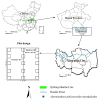Impacts of Soil Properties on Species Diversity and Structure in Alternanthera philoxeroides-Invaded and Native Plant Communities
- PMID: 38732411
- PMCID: PMC11085794
- DOI: 10.3390/plants13091196
Impacts of Soil Properties on Species Diversity and Structure in Alternanthera philoxeroides-Invaded and Native Plant Communities
Abstract
Soil properties can affect plant population dynamics and the coexistence of native and invasive plants, thus potentially affecting community structure and invasion trends. However, the different impacts of soil physicochemical properties on species diversity and structure in native and invaded plant communities remain unclear. In this study, we established a total of 30 Alternanthera philoxeroides-invaded plots and 30 control plots in an area at the geographical boundary between North and South China. We compared the differences in species composition between the invaded and native plant communities, and we then used the methods of regression analysis, redundancy analysis (RDA), and canonical correspondence analysis (CCA) to examine the impacts of soil physicochemical properties on four α-diversity indices and the species distribution of these two types of communities. We found that A. philoxeroides invasion increased the difference between the importance values of dominant plant species, and the invasion coverage had a negative relationship with the soil-available potassium (R2 = 0.135; p = 0.046) and Patrick richness index (R2 = 0.322; p < 0.001). In the native communities, the species diversity was determined with soil chemical properties, the Patrick richness index, the Simpson dominance index, and the Shannon-Wiener diversity index, which all decreased with the increase in soil pH value, available potassium, organic matter, and ammonium nitrogen. However, in the invaded communities, the species diversity was determined by soil physical properties; the Pielou evenness index increased with increasing non-capillary porosity but decreased with increasing capillary porosity. The determinants of species distribution in the native communities were soil porosity and nitrate nitrogen, while the determinants in the invaded communities were soil bulk density and available potassium. In addition, compared with the native communities, the clustering degree of species distribution in the invaded communities intensified. Our study indicates that species diversity and distribution have significant heterogeneous responses to soil physicochemical properties between A. philoxeroides-invaded and native plant communities. Thus, we need to intensify the monitoring of soil properties in invaded habitats and conduct biotic replacement strategies based on the heterogeneous responses of native and invaded communities to effectively prevent the biotic homogenization that is caused by plant invasions under environmental changes.
Keywords: Alternanthera philoxeroides; biological invasions; diversity index; habitat heterogeneity; plant community; species coexistence.
Conflict of interest statement
The authors declare no conflicts of interest.
Figures






References
-
- Fernandez R.D., Castro-Diez P., Aragon R., Perez-Harguindeguy N. Changes in community functional structure and ecosystem properties along an invasion gradient of Ligustrum lucidum. J. Veg. Sci. 2021;32:e13098. doi: 10.1111/jvs.13098. - DOI
-
- Livingstone S.W., Isaac M.E., Cadotte M.W. Invasive dominance and resident diversity: Unpacking the impact of plant invasion on biodiversity and ecosystem function. Ecol. Monogr. 2020;90:e01425. doi: 10.1002/ecm.1425. - DOI
-
- Carboni M., Livingstone S.W., Isaac M.E., Cadotte M.W. Invasion drives plant diversity loss through competition and ecosystem modification. J. Ecol. 2021;109:3587–3601. doi: 10.1111/1365-2745.13739. - DOI
-
- Wang C.Y., Wu B.D., Jiang K., Zhou J.W., Du D.L. Canada goldenrod invasion affect taxonomic and functional diversity of plant communities in heterogeneous landscapes in urban ecosystems in East China. Urban For. Urban Green. 2019;38:145–156. doi: 10.1016/j.ufug.2018.12.006. - DOI
Grants and funding
- 31800460/National Natural Science Foundation of China
- 2023XYMS16/Xinyang Academy of Ecological Research Open Foundation
- 232102110062/Science and Technology Research Project of Henan Province
- 24A180028/Key Scientific Research Projects of Higher Education Institutions of Henan Province
- 2023A017/Nanhu Scholars Program for Young Scholars of Xinyang Normal University (XYNU)
LinkOut - more resources
Full Text Sources

